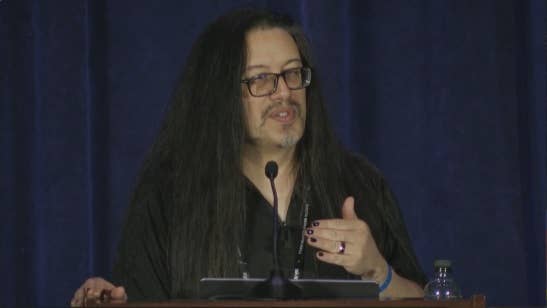John Romero recalls Sierra's attempt to acquire Id Software | GDC 2022
Designer says $2.5 million deal during Wolfenstein 3D development fell apart over a request for $100,000 in cash instead of stock
Sierra Online could have had the same impact on first-person shooters that it had on graphic adventures, as John Romero today discussed 1992 acquisition talks between the companies during a Game Developers Conference classic game postmortem on Wolfenstein 3D.
In his session, Romero talked about his love of the King's Quest series, and how he mailed King's Quest creator Roberta Williams a copies of Id's Commander Keen games because he had noticed the publisher starting to get into kids' games.
"She loved it and she asked if we would fly to their office to talk business," Romero said.
The Id team flew out to Sierra's office in California, visited co-founders Roberta and Ken Williams at their house, and showed them Wolfenstein 3D in its early development stages. Romero said Ken was not impressed.
"After about 30 seconds of watching, he wanted to show me the new game they were working on, Red Baron Online," Romero said. "I was dumbfounded. Like, here's the future, the start of a new genre: the first-person shooter. And Ken could not pay it any notice."
Despite that, Sierra showed interest in the company, particularly after seeing Id's books that showed it bringing in $50,000 a month from its shareware games. Romero said Ken tabled an offer to acquire Id for $2.5 million in company stock.
Romero said the Id team were thrilled at the idea of instantly getting four years' worth of revenues overnight and were prepared to accept the offer, but asked for $100,000 of the price to be paid upfront in cash.
"Ken thought about it for a second, then he was like, 'No thanks, but good luck with everything.' So the 100k was a little too rich for him."
Finding the fun
Romero also talked about the game's origins as a follow-up to the 1981 Apple II stealth game Castle Wolfenstein, and how it ended up offering players a very different kind of experience.
"When we started creating gameplay, we were replicating all of the original game's stealth features, like searching dead bodies, dragging those guards around so enemy soldiers wouldn't see them and become suspicious, and attempting to break into storage lockers for food and ammo," Romero said.
"But while we were adding these features to the game and playing the game constantly, we started to notice that the more fun part of the game was running and gunning. Stopping to drag a guard or unlock a chest really slowed down the innovative high-speed running and blasting Nazis that was the real fun core of the game."
Romero said the developers decided to focus on speed, simplifying the game design and removing any feature that slowed the game down, a decision that changed Wolfenstein 3D from a stealth game to a frenetic shooter.
"The entire time you're making the game, you're trying to find the fun as soon as you can. And sometimes the fun isn't in the features that you thought you were going to be fun. You have to really listen to the game."









